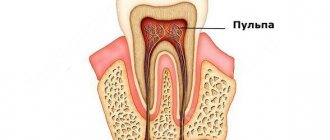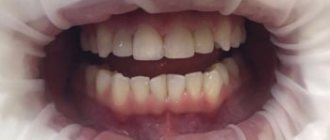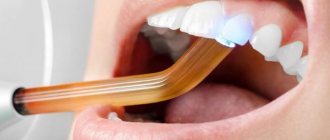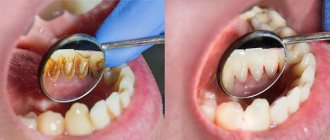When is it necessary to remove a nerve?
Dentists are trying their best to save the tooth, but, unfortunately, this is not always possible. For example, in case of extensive caries, it is necessary to resort to removing the nerve of the tooth. The nerve (pulp) is responsible for the sensitivity of the unit. Pain and other unpleasant symptoms arise precisely because of inflammation of the pulp. The following conditions are considered the main indications:
- Advanced periodontitis.
- Deep caries affecting the internal tissues of the tooth.
- Acute pulpitis.
Also, this manipulation is indicated in cases where crowns, bridges, veneers and other fixed prostheses are to be installed. First of all, this is done with the intention that the tooth does not get sick under the artificial structure. In this case, the unit is considered dead, but continues to perform its functional duties.
The third reason is incorrect calculation of the dosage of the drug
If you are going to treat pulpitis, be sure to contact only experienced specialists. After all, there are often cases of medical errors when the doctor, when putting the drug into the tooth cavity, makes a mistake with the dosage of the paste, does not take into account the patient’s age, the condition of the nerve and the size of the tooth.
The situation when you put arsenic on a tooth, and it hurts, can arise both in the case of an insufficient amount of the drug, and in the case of an excess of it. In the first situation, the paste was not enough to “kill” the sensory nerve, which is why it hurts. Experts call this condition “residual pulpitis.” In the second situation, pain is evidence of irritation of the periodontal tissues and the toxicological effect of an overdose of the drug.
How does arsenic remove a nerve?
Note that removing pulp using arsenic is an outdated technique. Most often it is practiced in public clinics. First, the patient is sent for an x-ray, then the tooth is processed with a drill and unimpeded access to the nerve of the tooth is created. Next, an arsenic-based paste is placed into the formed bed, and a temporary filling is placed on top. As a rule, it is removed after 1-3 days. After the filling is removed, the canals are cleaned, then a permanent filling is fixed.
Preventive measures
In order for the process of preparing for the main treatment to proceed without unpleasant surprises and dangerous complications, you must follow simple rules:
- Try not to put stress on the sealed unit. This means that you should chew food from the “healthy side”. Under no circumstances should you chew on foreign objects. Also, intensive rinsing should not be done unless prescribed by a doctor.
- Maintain good oral hygiene. It is necessary to carry out hygiene measures in the morning and evening. Inflamed areas of the gums can be treated with a brush with soft bristles.
- Check the temporary filling for cracks and chips. If they appear, a re-sealing should be carried out. Otherwise, by the time the permanent material is installed, there may be nothing left of the dental crown - it will collapse under the aggressive influence of pathogens.
Watch your tooth filled with a temporary filling carefully. Then you will avoid many problems.
Does it hurt?
In most cases, the process of pulp necrosis using arsenic is painless. This is due to the pain-relieving components that are present in the arsenic paste. Sometimes patients complain of moderate pain, and this is normal. If you are experiencing severe pain, we recommend that you immediately visit the dentist.
Significant pain is possible if the dentist violated the rules for performing this procedure, for example, put too little arsenic.
Ways to eliminate pain
The pain is usually mild in nature and manifests itself upon contact with heat or mechanical action (chewing). To suppress the syndrome, it is recommended to use:
- Nurofen;
- Ketorola;
- Pentalgina;
- Tempalgin and other drugs in the dosage prescribed by the doctor.
If the symptom does not disappear, then you must again seek help from the dentist before the end of the allotted period. Also, medical intervention will be required in case of intoxication of the body, change in the color of the enamel and swelling of the gums.
You can extract arsenic paste yourself. To do this, you should prepare a clean, pre-disinfected needle or tweezers, with the help of which the temporary filling is removed.
In the opened cavity there is a gray paste. It must be removed in one go, without swallowing. At the end of the procedure, you need to rinse your mouth with a soda solution or chamomile infusion.
Pain after applying arsenic is a normal phenomenon that goes away on its own over time. In other cases, when the discomfort does not disappear, you need to contact your dentist to remove the toxic paste.
Further recommendations
When arsenic is present, the following rules must be followed:
- It is not recommended to use painkillers.
- Do not try to heat the tooth, even if it hurts. Such measures can lead to complications.
- For three hours after the temporary filling is installed, try to refrain from eating and drinking.
- Do not rinse your mouth.
If the doctor claims that it is necessary to resort to the removal of the dental nerve, there is no need to panic or refuse this procedure. If this is not done in a timely manner,
the tooth
removed completely. Even after depulpation, the tooth will last for many years.
Pain in a tooth after a temporary filling is placed - normal or pathological?
If, after several days or a week of keeping a temporary filling with a medicinal drug under it, with the pulp preserved, intense pain continues, does not tend to decrease, increases with temperature and chemical stimuli, or signs of complications appear (sharp throbbing pain, swelling of the tissues surrounding the tooth, swelling of the cheek, signs of general intoxication, fever, enlargement, soreness of peripheral lymph nodes, etc.) – an urgent appointment is required to review treatment tactics.
It is concluded that there is severe inflammation of the pulp that is not amenable to biological treatment and that it must be removed. In this case, a devitalizing arsenic-containing or paraformaldehyde paste is placed for a period depending on its composition (from two days to a week), followed by depulpation and cleaning of the canals. After placing such pastes under a temporary filling, after the required time has passed, depending on the type of paste, the tooth should stop hurting due to the death of the nerve. If this does not happen, we can assume that the drug was poorly delivered and had a bad effect on the pulp, or the pulp is completely necrotic and the canals are filled with pus (in this case, swelling of the gums is added to the clinical symptoms), in such cases you should urgently consult a specialist.
In case of any progression of pain or the addition of other symptoms, urgent treatment is necessary with removal of the filling, re-cleaning of the canals and long-term step-by-step treatment, and in some cases even surgical treatment.
Features of pain under a temporary filling in various diseases
The different nature of pain is, to one degree or another, inherent in different inflammatory processes.
Thus, a characteristic sign of acute pulpitis is intense pain in the tooth, often manifesting itself in the form of attacks lasting up to half an hour, worsening at night, when eating food of contrasting temperature, radiating to neighboring areas.
Chronic pulpitis is manifested by mild, spontaneously occurring periodic pain, also associated with eating food of contrasting temperature.
Intense, acute, increasing twitching, paroxysmal pain is also characteristic of acute purulent periodontitis.
Gradually developing, aching, bursting pain with the sensation of an “overgrown tooth” is characteristic of chronic periodontitis.
Mild aching pain is characteristic of ongoing inflammation in the pulp and at the top of the tooth during the action of devitalizing pastes.
Of course, it is categorically impossible to completely rely on the nature of the pain and try to diagnose yourself; you should definitely consult a qualified dentist, who, based on examination data and objective research methods, will accurately diagnose and carry out appropriate treatment.
Why does pain occur?
The pain syndrome that occurs after applying arsenic paste to a tooth indicates that the inflammatory process has affected healthy tissue. This phenomenon is often complicated by suppuration and sepsis.
Pain develops under the influence of several factors.
Dentist mistakes
There are two errors that lead to pain. The first is the incorrect dosage of the drug. In particular, arsenic, applied in insufficient quantities, is not able to destroy the entire nerve. Because of this error, the pathological process continues.
The second is the incorrect administration of the drug. If arsenic comes into contact with gum tissue, the latter becomes inflamed under the influence of the toxic substance. The result is pain.
Necrosis of bone tissue
It is considered the most severe consequence of surgery to remove the affected nerve. Necrosis of bone tissue occurs due to the toxic effect that arsenic has on it. This process can lead to its atrophy.
Allergic reaction
Another common cause of pain. In this case, it represents the reaction of the immune system to the action of the components of arsenic paste.
Inflammation that affects adjacent tissues
This factor is often associated with a mistake by the dentist, who made an incorrect diagnosis, or the patient’s delay in seeking help. The appearance of pain after arsenic testing may indicate the course of the following pathologies:
- periodontitis;
- periostitis;
- periodontitis;
- phlegmon;
- abscess.
These diseases are a consequence of advanced caries. In addition to pain, the course of pathologies is accompanied by the appearance of swelling and other symptoms.
Long-term wearing of a temporary filling
After arsenic is administered, the toothache disappears for a while, so people often forget about the need to return to the dentist to remove the toothpaste. Over time, the active substance penetrates deeper, affecting healthy tissue and causing discomfort.
Why can our articles be trusted?
We make health information clear, accessible and relevant.
- All articles are checked by practicing doctors.
- We take scientific literature and the latest research as a basis.
- We publish detailed articles that answer all questions.
The factors causing the occurrence of the phenomenon under consideration also include patients’ non-compliance with the doctor’s recommendations after arsenic administration. During the period allotted by the dentist, the patient is prohibited from:
- use the affected tooth for chewing;
- apply heat to the painful area;
- drink plenty of painkillers .
Each of the described actions can lead to the development of pain.
Use of arsenic in dentistry
The paste, which is based on the oxide of this poison, has a destructive effect. Therefore, it can be used before removing the nerve. What are the properties of the paste?
- It has a fairly high degree of toxicity;
- It acts as a pain reliever;
- The mixture has a pronounced antibacterial effect;
- Its action is prolonged;
After a day or two, arsenic kills the nerve in the tooth. Patients with a low pain threshold do not feel pain during extraction of such a masticatory organ. It happens that the operation is performed after an injection with an anesthetic substance. Most often, the mass is laid for 1-2 days. The duration depends on the complexity of the pathology of the unit. It is extended when the multi-channel unit is disturbed.
To determine the duration of action of the drug, the doctor takes into account its composition. As a rule, more than half of the paste consists of anesthetic components and anhydride, which has a necrotic effect. Also, antiseptics, tannin for binding ingredients, and fillers are added to the mass.
Possible side effects
Arsenic is placed in the tooth so that it deadens the nerve. But its action can cause complications. How dangerous is this? If you consult an experienced doctor who will use not pure poison, but its derivative, there is nothing to worry about. The paste is placed deeply and sealed on top, so it does not enter the stomach. High doses of the substance and its untimely removal are harmful. In this case, there is a risk of inflammation, periostitis, periodontitis. Continuing to walk with poison longer than prescribed is dangerous! After all, prolonged contact with tissues poisons the body. Untimely removal and excessive dose cause:
- Darkening of dentin;
- Inflammation of the tissues surrounding the unit;
- Pulp swelling, pulpitis;
- Necrosis of bone tissue and periosteum;
- General intoxication; poisoning of the body.
Sometimes it happens that the pain becomes stronger and becomes tearing. This happens when the dose of the substance is too small or the threshold of vulnerability is high, as well as with necrosis of the periosteum and individual intolerance.
Arsenic during pregnancy and in pediatric dentistry
Often, tooth root removal is required for pregnant women or children. During pregnancy and the appearance of milk units, the paste is used very rarely.
- Firstly, the issue of the effect of toxins on the delicate roots of temporary teeth and the embryo has not been sufficiently studied.
- Secondly, it is difficult to correctly calculate the tiny dose for children.
- Thirdly, a child may accidentally swallow the fallen paste.
Therefore, the substance is used only as a last resort when the patient is allergic to anesthesia. Due to high risks, the toxic substance is replaced with a safe one. When the pediatric dentist is forced to use the paste, its action time is reduced to a minimum. In other cases, alternative pulp necrotization technologies are used.











